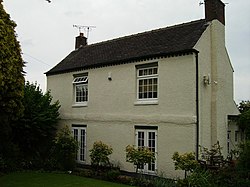Difference between revisions of "Loscoe"
(Created page with '{{Infobox town |name=Loscoe |county=Derbyshire |picture=Loscoe 503090 b6abed9b.jpg |picture caption=Highfield House |os grid ref=SK4224547796 |latitude=53.0258 |longitude=-1.3716…') |
m (clean up, typos fixed: 7 hour → 7-hour) |
||
| Line 19: | Line 19: | ||
==1986 landfill gas explosion== | ==1986 landfill gas explosion== | ||
| − | Loscoe was the site of a landfill gas migration explosion on 24 March 1986. Although there were no fatalities, one house was completely destroyed by the blast and the three occupants injured. On the night of the explosion the atmospheric air pressure fell by 29 hPa (29 mbar) over a 7 hour period, causing the gas to be released from the ground in much greater quantities than usual.<ref>{{Cite news|title=When barometric pressure is lethal|work=Irish Times|location=Dublin|date=5 July 2003|first=Brendan|last=McWilliams|page=24}}</ref> In the four hours before the explosion, which occurred at approximately 6.30am, the local meteorological office had recorded average falls of 4 hPa (4 mbar) per hour.<ref name="newscientist">{{Cite journal|first=Roger|last=Milne|title=Methane menace seeps to the surface|journal=New Scientist|date=25 February 1988|page=27|volume=117|issue=1601|issn=02624079}}</ref> Several cubic metres of landfill gas (consisting of a 3:2 mixture of methane and carbon dioxide) collected under the ground near 51 Clarke Avenue and as the gas expanded it flowed into the space beneath the floor from where it was drawn by convection to the gas central heating boiler and ignited.<ref name=newscientist/> | + | Loscoe was the site of a landfill gas migration explosion on 24 March 1986. Although there were no fatalities, one house was completely destroyed by the blast and the three occupants injured. On the night of the explosion the atmospheric air pressure fell by 29 hPa (29 mbar) over a 7-hour period, causing the gas to be released from the ground in much greater quantities than usual.<ref>{{Cite news|title=When barometric pressure is lethal|work=Irish Times|location=Dublin|date=5 July 2003|first=Brendan|last=McWilliams|page=24}}</ref> In the four hours before the explosion, which occurred at approximately 6.30am, the local meteorological office had recorded average falls of 4 hPa (4 mbar) per hour.<ref name="newscientist">{{Cite journal|first=Roger|last=Milne|title=Methane menace seeps to the surface|journal=New Scientist|date=25 February 1988|page=27|volume=117|issue=1601|issn=02624079}}</ref> Several cubic metres of landfill gas (consisting of a 3:2 mixture of methane and carbon dioxide) collected under the ground near 51 Clarke Avenue and as the gas expanded it flowed into the space beneath the floor from where it was drawn by convection to the gas central heating boiler and ignited.<ref name=newscientist/> |
This disaster led Parliament to introduce legislation much research was begun into landfill behaviour<ref>[http://users.ox.ac.uk/~ayoung/landfill.html DoE Report CWM039A+B/92] Young, A. (1992)</ref> and best practice at landfill sites. Over time, these were designed to vent gas to atmosphere, then to burn off methane and eventually in the most productive, to turn the gas into electricity using gas turbines which supply the national grid. | This disaster led Parliament to introduce legislation much research was begun into landfill behaviour<ref>[http://users.ox.ac.uk/~ayoung/landfill.html DoE Report CWM039A+B/92] Young, A. (1992)</ref> and best practice at landfill sites. Over time, these were designed to vent gas to atmosphere, then to burn off methane and eventually in the most productive, to turn the gas into electricity using gas turbines which supply the national grid. | ||
Latest revision as of 14:21, 27 January 2016
| Loscoe | |
| Derbyshire | |
|---|---|
 Highfield House | |
| Location | |
| Grid reference: | SK4224547796 |
| Location: | 53°1’33"N, 1°22’18"W |
| Data | |
| Population: | 1,500 |
| Post town: | Heanor |
| Postcode: | DE75 |
| Dialling code: | 01773 |
| Local Government | |
| Council: | Amber Valley |
| Parliamentary constituency: |
Amber Valley |
Loscoe is a small village near Heanor in Derbyshire.
The research for Highfield House dates back to 1650 or possibly as early as 1630. This may now be the oldest surviving house in Loscoe as many houses in the village were demolished due to mining subsidence.
1986 landfill gas explosion
Loscoe was the site of a landfill gas migration explosion on 24 March 1986. Although there were no fatalities, one house was completely destroyed by the blast and the three occupants injured. On the night of the explosion the atmospheric air pressure fell by 29 hPa (29 mbar) over a 7-hour period, causing the gas to be released from the ground in much greater quantities than usual.[1] In the four hours before the explosion, which occurred at approximately 6.30am, the local meteorological office had recorded average falls of 4 hPa (4 mbar) per hour.[2] Several cubic metres of landfill gas (consisting of a 3:2 mixture of methane and carbon dioxide) collected under the ground near 51 Clarke Avenue and as the gas expanded it flowed into the space beneath the floor from where it was drawn by convection to the gas central heating boiler and ignited.[2]
This disaster led Parliament to introduce legislation much research was begun into landfill behaviour[3] and best practice at landfill sites. Over time, these were designed to vent gas to atmosphere, then to burn off methane and eventually in the most productive, to turn the gas into electricity using gas turbines which supply the national grid.
Outside links
| ("Wikimedia Commons" has material about Loscoe) |